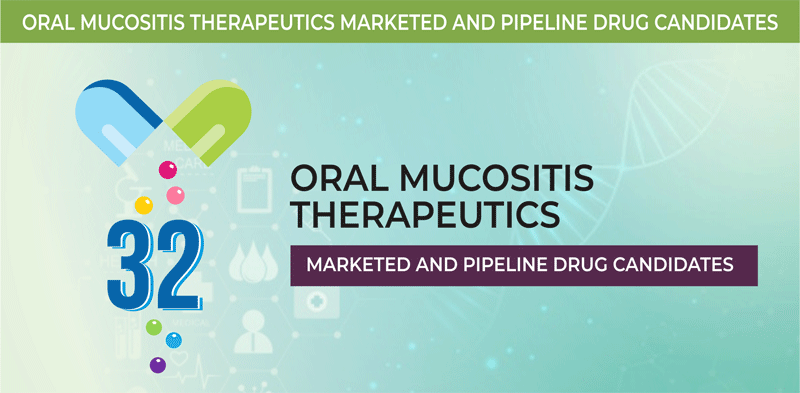International: +1-347-960-6455
US/Canada Toll Free:+1-888-778-7886

| Report Code: PP10243 | Published: October 2019 | Pages: 200 | Available format: |
| Therapeutic Area(s): | Oncology | Report Type: Indication Pipeline Reports |
Overview
Oral mucositis (OM) is the most common side-effects of cancer treatment (chemotherapy and/or radiotherapy), and occurs usually in the people suffering from head and neck cancer. It causes damage to mucosal lining of mouth leading to the formation of ulcers and infections. The disease usually occurs within 5–10 days after a chemotherapy treatment in cancer patients. Problems occurring due to OM are severe pain in mouth, lack of nutrition due to inability to eat, and increased risk of infections due to open sores in oral cavity. The disease usually lasts for one week to six weeks or more.

Symptoms associated with OM include open sores or bleeding, pain, redness or swelling, white patches, dry mouth, diarrhea, nausea, thicker saliva in the mouth, and difficulty in talking or swallowing. OM can be diagnosed through various tests, including biopsy and fungal testing. Antiseptic mouth rinses, pain killer medicines, water-soluble lubricating agents, bland rinses, and mucosal coating agents are some of the products used for the treatment of OM.
Kepivance (Amgen Inc.), a human keratinocyte growth factor, is used to treat OM. Other products commercialized for the prevention of OM include, GelX (Sunstar Suisse SA), NeutraSal (Bausch Health Companies Inc.), Easyef (Daewoong Pharmaceutical Co. Ltd., and Caphosol (Eusa Pharma (UK) Limited).
A number of drug manufacturers is actively involved in the development of OM therapeutics. For instance, Galera Therapeutics Inc. is developing GC4419, to treat patients with OM undergoing radiation and chemotherapy. The results from the phase Ib/IIa clinical trial of GC4419 showed that GC4419 was safe and delayed the onset of severe OM.
Positive clinical trial results and adoption of collaboration strategies are enhancing OM therapeutics pipeline. Moreover, the issuance of patents helps in achieving different milestones in the form of grants and designations from regulatory bodies and institutes, including the U.S. Food and Drug Administration (USFDA), the European Medicines Agency (EMA), and the National Institutes of Health (NIH), among others.
Pipeline Analysis
As of March 2019, the OM therapeutics pipeline comprised 23 drugs (in addition with 9 marketed drugs) in different stages of development.
Epidemiology Analysis
The report provides epidemiology forecast of OM for 7 major markets (7MMs) which includes the U.S., Japan, and EU5 countries (the U.K., Germany, France, Italy, and Spain). It covers prevalent population and treated patient population for the period 2016–2024. According to an article published in Frontiers in Oncology 2017, radiation-induced OM (RIOM) occurs in up to 80% of head and neck cancer patients. In addition, it has been observed that approximately 40-60% patients undergoing cancer treatment are affected by OM.
Competitive Landscape
Some of the key players involved in the development of OM therapeutics are Galera Therapeutics Inc., Amgen Inc., Daewoong Pharmaceutical Co. Ltd., Innovation Pharmaceuticals Inc., Bausch Health Companies Inc., Camurus AB, Swedish Orphan Biovitrum AB, Moberg Pharma AB, and Soligenix Inc.
Report Insights
Some highlights of the report “Oral Mucositis (OM) Therapeutics – Pipeline Analysis 2019, Clinical Trials and Results, Patents, Designations, Collaborations, and Other Developments” have been mentioned below: